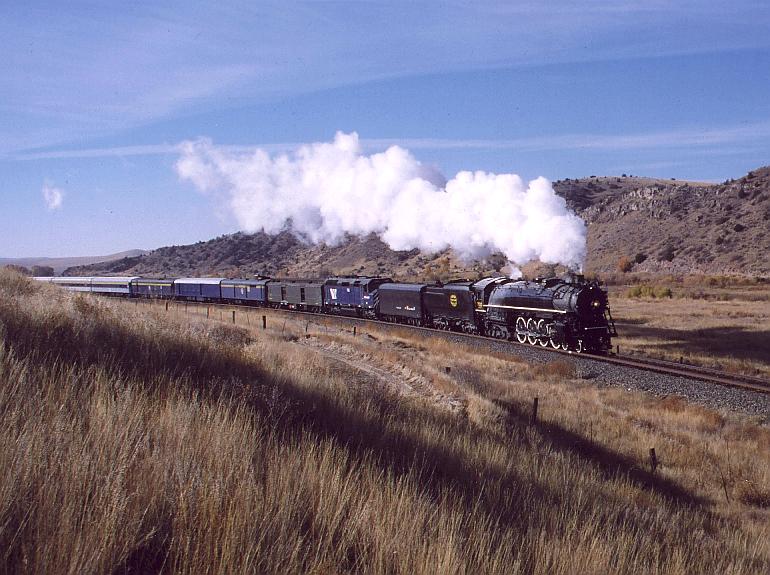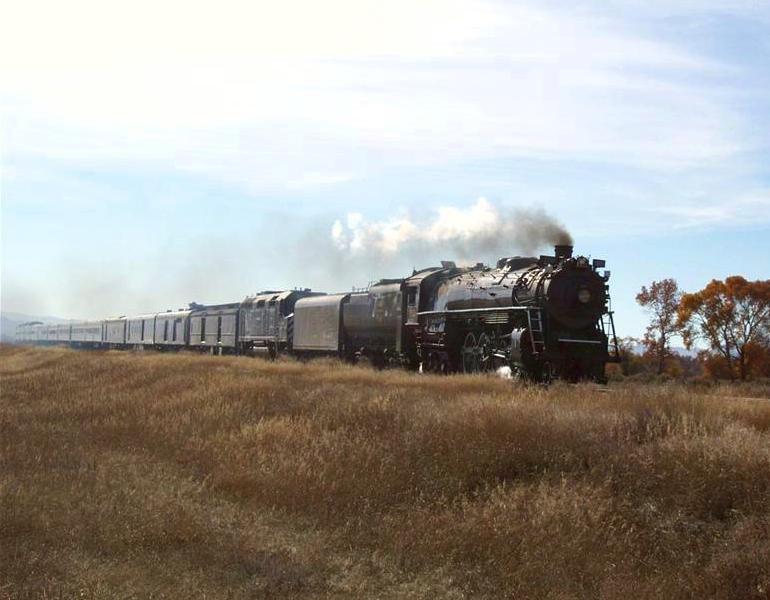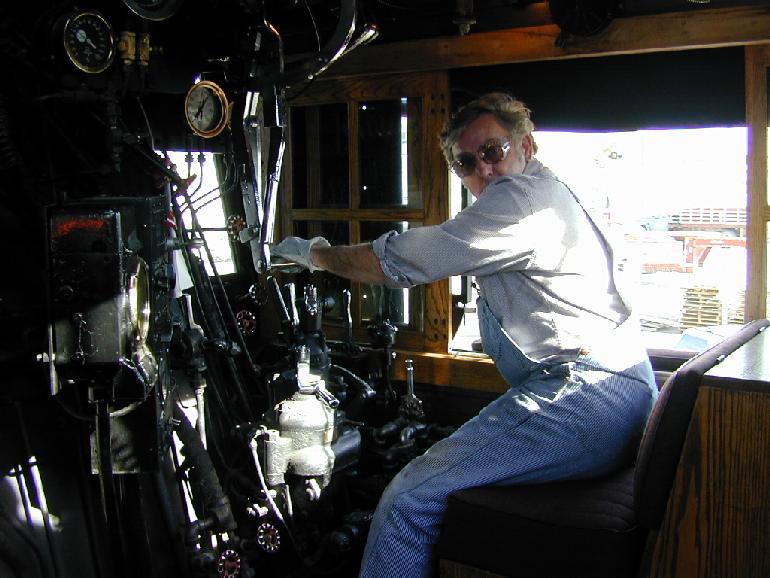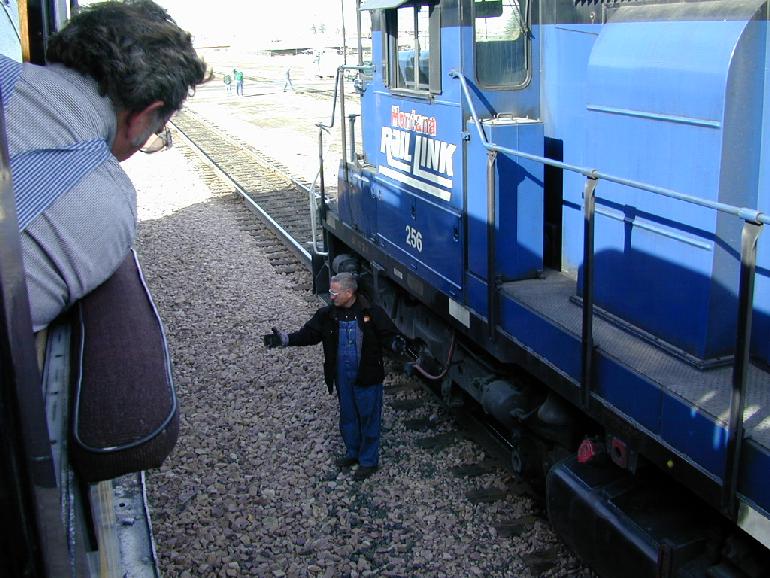
Another photo taken during my run by Mark Minkler.

Finally the end of the canyon and its 25 mph restriction was near. A yellow 40 mph sign passed by the cab and I called it out to the rest of the crew. When the entire train was by it I opened the throttle some more. There's that power again. The stack talk increased and rhythm picked up still more. Taking a que from Jim's performance I got a little bolder. I opened the throttle over half way. Now she really started shouting and we surged ahead even faster. A green board sailed past. It signified the end of the 40 mph and the resumption of 60 mph track. I opened the throttle 2/3rds. The exhaust beats were merging into a continuous roar of steam. 50 mph. 55 mph. It appeared we were climbing a grade lifting us up out of the confines of the canyon onto a low bench along the river.
After 9 miles of 25 mph we were now really moving! I saw a yellow signal up ahead and called "Approach" across the cab. I eased off a little on the throttle and reached for the air brake. Bob strolled across the cab to look but the signal changed to green just as he stuck his head out the gangway behind me. Bob said the dispatcher had told him earlier that we were meeting one at Toston. Apparently it had just gotten in the clear.
I didn't set the air and instead opened the throttle back up. We were coming into Toston at 55 mph. An orange BNSF freight was in the clear in the siding. Fans and crew were standing around taking pictures as we flashed by. I tried some fancier whistling but mine is no match for Jim's. My steam whistling needs some practice. Now there were more crossings to whistle and fans everywhere.
The exhaust and machinery did not sound "right" to me. Maybe I noticed a difference between its sound and feel now as opposed Jim's earlier running. What ever it was I decided to try adjusting the cut-off. I reached for the reverser and released the handle lock. I pushed the handle forward slightly. The sound seemed smoother, rounder. I latched the reverser. Maybe it was my imagination but I was surprised at how such a small change in the reverser position could make such a change in the sound of the exhaust and the feel of the machine. If I recall correctly the backpressure went from about 5 psi to 8 psi when I did that. Apparently the machine likes the extra cushioning.
The Chicago-Pneumatic speed recorder is reading 60 mph. I throttle down a bit. The roar is tremendous and the ride is thrilling. At the risk of repeating myself, this is AWESOME!
Fans are pacing us on the adjacent highway. I see cameras pointed out of driver's side windows. People who knew nothing of the train stopped and stared.
Just east of the Toston detector David Herzberg took these photos as I charged by at sixty miles per hour.


Yes the headlight was on. It just doesn't show up well in a bright backlit picture. I know the speed was 59-60 mph because about one quarter mile later we went by the Toston detector and it said, "Speed five nine miles per hour". Every detector we went over gave us hotbox alarms. As long as they were on the first 8 axles we ignored them.
I was now getting familiar with the locomotive and train and could relax a bit more. I was just plum enjoying the experience. The videographer in the cab had taken most of his footage of me running just as I had started out in the canyon and early in my run. I was concentrating on the new machine and I looked like a grumpy old hoghead. No time for smiling then. Now that I am grinning he is not filming. I am sort of hoping that my part of the tape ends up on the cutting room floor.
Now I am more relaxed and I can do the P.R. work of waving and smiling at the crowd. Or am I smiling at myself and at the experience? I hold onto my cap and lean out of the cab window. I watch the rods flashing up and down. The valve gear does its dance. I sit back down on the seat box.
Someone taps me on the shoulder. I turn around and see Jim pointing to the speed recorder. Damn! It is a tad bit above 60 mph. (No I am not going to define a "tad bit" here). I reduce the throttle a bit and instantly realize that isn't going to do it. I set the air brakes. A fast split reduction of 10-11 psi. I kick it off as soon as it takes hold and we are back where we belong. At least Jim is still smiling and he didn't yank me out of the seat by my collar. After that I paid more attention to what I was doing and less attention to the fans and ladies along the track.
It is eleven straight fast miles to Townsend. Bob tells me we have to stop there to pick up an MRL trainmaster. The green block signals fly by. The exhaust is laying down back along the train. It seems as if the crossings come one right after another. I wonder if you can run her out of steam by whistling too much.
In the distance a signal shines yellow. "Approach". Bob says this the approach to Townsend. He says the trainmaster will be at the depot. That would be a help if I knew where the depot was.
I reduce the throttle and set the air brakes. We are still flying low. Bob says the trainmaster will be next to a white station wagon. Jim tells me to spot the cab right in front of him. Uh huh. I tell him that I like to make trainmasters walk.
I can see there is another BNSF orange train pulling into the siding up ahead. The speed is dropping fast as we roll by the approach signal. I let it drop to the 35 mph required by an Approach on the MRL. I make a partial release. Now I can see a white something far ahead but is it a station wagon or a shack? It is the station wagon.
I increased the air brake reduction. We are slowing through 20mph. I have the throttle almost closed but the unbraked weight of the 700, its two tenders, and the F45 continue to pull on the train. It looks like I might be a little long on the stop so I make a final reduction. From my perch on the seatbox we make what appears to me to be a smooth stop. The trainmaster is standing next to the boiler. I wondered if I had stopped short enough that the gates would go up. Yes, after a few seconds they went up. Not bad for my first stop. I moved the power reverse lever to full forward.
I wondered if I spilled any passengers' coffee or made them take a step forward with that stop. I had about 13-14 psi set with that last reduction. Ideally II would liked to have made a partial release before the stop but if I had then the 700 would have blocked the crossing. After returning home I conversed with several people on the internet who were aboard the train. I asked how the ride was and each of them said it was good and that they had noticed no difference during the part I was running. So I guess I did alright.
There was a crowd gathered next to the engine. Most of them taking pictures. I sure wish I could find some of them because that is the most likely place a photo would clearly show me as the engineer.
An elderly gentleman yelled up at me in the cab, "How big are those drivers?"
It occurred to me that I didn't know. I had asked the same question of my conductor when we visited the 700 in Billings. He had said they were 80". I turned around and asked Jim. "Seventy Seven inches" he said.
I hollered out the window, "77 inches". That satisfied the fellow but I couldn't help wondering if he'd gone home and told his wife that the engineer did not even know what size drivers his locomotive had.Since we were picking up the trainmaster and an SP&S benefactor the videographer left the cab. I relinquished the engineer's seat to Bob for the run from Townsend to Helena over Winston Hill.
I realized that Jim had known what he was doing in having me run through the canyon instead of just up and over Winston Hill. The slower pace in the canyon had given me time to get familiar with the 700. I got far more experience operating the locomotive over the constantly changing grades and the up and down speed limits than I would have if I had just "put her in eight" and gone up the hill, then throttled down and set air to go down to Helena. The extra time and experience let me relax more when I finally got out on the fast and straight. That Jim, he is a wise one.
We were stopped only a few minutes at Townsend. Bob introduced me to the trainmaster then whistled off and got her rolling. Then he made a run for the hill. About a mile west of Townsend the track crosses the Missouri River on a multispan through truss bridge. Winston Hill begins at the bridge.
Bob was hanging out of the cab window waving at the ladies. I hollered at him. He whirled around thinking something was wrong. I snapped his picture.

The 700 has a very long and very wide boiler. Visibility past the boiler is extremely limited. Especially to the opposite side of the track. In steam days all signals were on the right hand side of the track so the engineer could see every one of them. But since the mid-1970s railroads have been repositioning many signals to the left side of the track. That works for short nosed diesels but it makes it impossible for a steam engineer to see them.Terry's student fireman was the only person in the cab who could see the left hand signals. He was busy enough learning his work and also he was not familiar with block signals. Since I was an engineer the trainmaster instructed me to watch for and call signals from the left gangway. That is where I rode for the rest of the trip to Helena.
View from the left side gangway climbing Winston Hill.

Whenever the 700 was worked hard for long periods of time the crew could be heard complaining of the fuel. The locomotive was designed to burn Bunker C fuel oil but Bunker C is hard to obtain now days. As I understood it the SP&S 700 was burning a low grade fuel, re-refined lube oil or something like that. Probably recycled oil that got drained from our automobiles at places like Jiffy-Lube. Unfortunately this oil did not have the same BTU heat content as Bunker C and it was impossible to keep the boiler pressure at 260 psi on long hard pulls.
Bob made a valliant effort at charging the hill. The 700 was working very hard and putting on quite a show. But despite her best efforts to maintain track speed the inevitable pull of gravity began to take its toll. As the train slowed on the hill the stack talk was spectacular.
I kept an eye on the boiler pressure gauge. It steadily fell from 260 psi and a few miles from the top of the hill it was down to 200 psi. That is only 77% of full pressure. From my perch in the left gangway I could not see the steam chest gauge or the backpressure gauge. By the time we reached east Winston we were down to 24 mph. The 700 was suffering from the double whammy of the grade and the low boiler pressure caused by the low-heat fuel. Once on top though she wasted no time at all accelerating the train back to track speed.
It was a fast ride from Winston to Louisville and East Helena. At one point while riding the gangway the 60 mph wind blew my SP&S 700 hat off my head and it disappeared up over the tender. I figured that was the last I'd ever see of that hat but I could buy a replacement in Helena when we stopped. Chalk it up as just one more hat I've lost to the wind while working on trains.
Several miles later, still at track speed, I was looking up over the tender through the gap between it and the cab roof. I was watching the billowing smoke/steam plume trail back over the train. It was then that I saw an amazing thing, the wind was flapping the bill of a hat up into view. My hat! I shuffled a couple of the crew's grips aside from the tender "seat" and climbed up so I could see the top of the tender. There was my hat being held down by the wind curling over the cab roof. I made a grab for it and retrieved it.
Bob slowed the train as we approached East Helena. The trainmaster came over to the left side and said I could stop watching for signals now as that was the last one. But I remained in the gangway since it was the best place to watch the locomotive and the crowds lining the tracks.
All too soon it seemed we were stopping at the Helena depot. I had been riding/running the 700 for over four hours. To say I was high would be an understatement.

I thanked Jim for the wonderful experience and took a long final look around the cab. Jim dismounted on the right and directed Bob at spotting the locomotive. Come on, Bob, just this much farther.

I climbed down the left side onto the depot platform. My wife was there to greet me. We took one last walk past the 700.
As we walked to our Explorer Linda told me she had been standing near the east end of the platform awaiting our arrival. Standing next to her was an elderly lady perhaps in her eighties. The lady was dressed in her Sunday finery and stood with quiet dignity. When they first heard the wailing of the 700's whistle the little old lady let out a whoop and clapped her hands. A broad smile filled her face as the steam locomotive approached. Linda could tell from her eyes and expression that the SP&S 700 was triggering a flood of memories from a time long ago. How many times at how many depots has the 700 performed that service? The volunteers and the crews of the 700 should be proud of their contributions to the public.
THANKS to you all I wish to profoundly thank Jim Abney, the man who made my dream come true. I'd also like to thank Terry Thompson, Bob Bateman, all of the SP&S 700 and Pacific Railroad Preservation Association volunteers and supporters, and the MRL, BNSF, and UP railroads for making this trip possible. And last but not least, my wife, Linda, who did not let me quit when things looked iffy. It was one of the best days in this reporter's life.



| Return to Tales index | My Home Page | E-Mail me |
Created 10-25-2002
Updated 11-20-2002